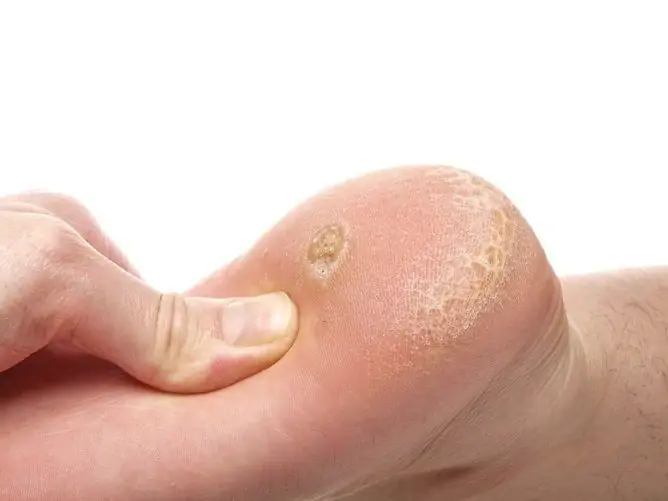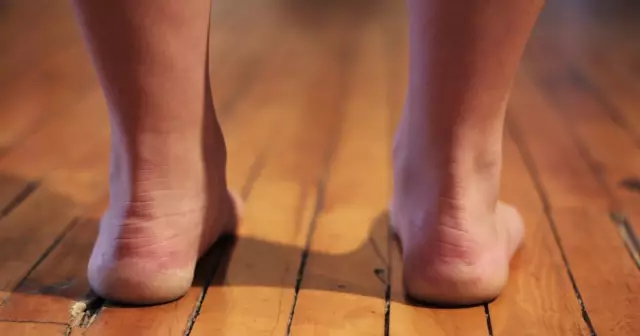- Author Rachel Wainwright [email protected].
- Public 2023-12-15 07:39.
- Last modified 2025-11-02 20:14.
Heel spur
Brief description of the disease

How is a heel spur treated? This question is relevant for hundreds of thousands of people, since this disease can manifest itself in any person at any age. It is characterized by sharp, sometimes unbearable pain when resting on the heel. Many patients say that the heel spur is like a nail that haunts them day and night. And that is why researchers from different countries work tirelessly to develop new drugs and techniques that could save patients from terrible suffering.
As for the disease itself. A heel spur is a soft tissue change resulting in bony overgrowth in the plantar heel. The growths (often called thorns) are of different sizes. However, the intensity of pain does not depend at all on this. It often happens that large thorns are practically not felt, but small growths turn a person's life into hell.
Reasons for the formation of a heel spur
In the overwhelming majority of cases, the heel spur develops against the background of flat feet. The fact is that with flat feet, the distribution of the load on the foot and the tension of the tendons change significantly. As a result, inflammatory processes of the surface layer of bone tissue begin to form in the area of the foot. This is how a heel spur appears, the symptoms of which significantly reduce the quality of human life. In addition to flat feet, the causes of the disease can be: metabolic disorders, acute and chronic heel injuries, malfunctioning of the circulatory system, poor vascular permeability, as well as some chronic inflammatory diseases - polyarthritis, arthritis, ankylosing spondylitis.
Regardless of the cause, heel spur treatment should begin as soon as possible. With the main efforts of doctors are focused on eliminating the main factor that caused the development of inflammation. Note also that the popular treatment of the heel spur, which has been fashionable in recent years, does not solve the problem of acute pain. Of course, folk remedies are able to temporarily reduce the intensity of pain, but they do not eliminate the causes of their occurrence, so the fate of a surgeon or orthopedist in the treatment process is mandatory.
Heel spur - symptoms and clinical picture
As mentioned above, the main symptom of a heel spur is severe pain in the heel area, which manifests itself in almost any load on the leg. At first, the pain may subside by the middle of the day, but then it becomes constant, torments the patient at any time of the day. For this reason, many people diagnosed with a heel spur move with crutches in order to somehow reduce the load on the heel.
Heel spur - traditional treatment
When choosing a method for treating inflammation, doctors take into account a variety of factors, including the cause of the disease. As a rule, they stop at the conservative treatment of the heel spur, which includes:
- massage and therapeutic exercises aimed at normalizing the work of the circulatory system;
- ultrasound, UFO, laser therapy, electrophoresis, magnetotherapy and other physiotherapeutic procedures;
- reducing the load on the inflamed area, for which orthopedic insoles, special shoes and crutches are used;
- shock wave therapy is a new and rather effective method of treatment, but not everyone is prescribed it, since shock wave therapy can lead to all sorts of complications.

If conservative treatment of the heel spur does not lead to the expected results, then the patients are prescribed a drug blockade. This procedure consists in the introduction of anti-inflammatory drugs, but only an experienced specialist should carry out it, since it is required to accurately determine the number of drugs, as well as the place and depth of their administration. If everything is done correctly, the symptoms of a heel spur will disappear for several years, but in case of an error, various complications may appear, for example, suppuration at the injection site, destruction of fascia or necrosis of soft tissues.
In the later stages, the heel spur is treated with surgery. Indications for it are limited, which is associated with high risk and severe consequences, however, in some situations, surgery is really the only way out.
Heel spur - treatment with folk remedies
Folk recipes are designed for long-term use, so the effect of them appears 3-6 weeks after the start of the course of treatment. And in any case, you should consult with your doctor so that the traditional treatment of heel spurs does not lead to even more pain. As for the recommended procedures, we have listed the most effective of them below:
- twist the flagellum from the birch bark, shape it into a pretzel, wrap it with a bandage and place it into the shoes so that the heel falls exactly into the resulting hole. This will reduce the stress on the inflamed area;
- do warm foot baths before bed - they use 0.5 liters of water with the addition of a glass of urine. The duration of the procedure is 15-30 minutes. After it ends, it is better not to wipe your feet, but to let them dry, then put on warm socks and go to bed. Also, a strong saline solution can be used for the baths (2-3 tablespoons of salt per 1 liter of water), but in this case, the procedure takes already 30-40 minutes;
- attach a slice of lard to the sore spot and fix this peculiar compress with a bandage. You can use raw potatoes instead of bacon;
- grate black radish on a fine grater and apply the resulting gruel to the spur every day for a night's rest. In this case, the alternative treatment of the heel spur will bear fruit after 3-4 sessions. At least, acute pains will subside, which is extremely important for people who sometimes cannot sleep due to painful sensations in the heel.
YouTube video related to the article:
The information is generalized and provided for informational purposes only. At the first sign of illness, see your doctor. Self-medication is hazardous to health!






